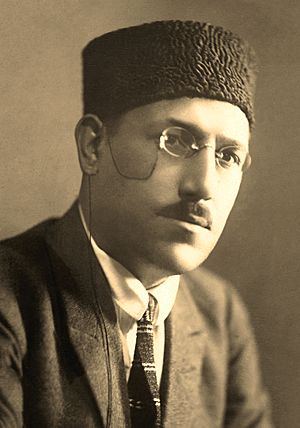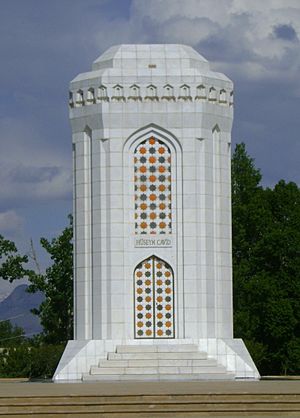Huseyn Javid facts for kids
Quick facts for kids
Huseyn Javid
Hüseyn Cavid |
|
|---|---|
 |
|
| Born |
Huseyn Abdulla oghlu Rasizadeh
October 24, 1882 Nakhchivan
|
| Died | December 5, 1941 (aged 59) Shevchenko, Tayshetsky District, Irkutsk Oblast
|
| Cause of death | Exile |
| Burial place | Huseyn Javid Mausoleum |
| Nationality | Azerbaijani |
| Occupation | Poet, playwright |
|
Notable work
|
Iblis (The Devil) |
| Signature | |
 |
|
Huseyn Javid (Azerbaijani: Hüseyn Cavid) was an important Azerbaijani poet and writer from the early 1900s. His real name was Huseyn Abdulla oghlu Rasizadeh. He was born on October 24, 1882, in Nakhchivan, and he passed away on December 5, 1941, in Shevchenko, Tayshetsky District. Javid helped start a new style of writing in Azerbaijani literature called "romanticism," which focused on feelings and big ideas. He was later sent away from his home during a difficult time when the government controlled many things in the USSR.
Contents
Early Life and Education
Huseyn Abdulla oghlu Rasizadeh was born in 1882 in Nakhchivan. His family was religious. After finishing his first school in 1898, Javid went to a special school called Maktab-i Tarbiya. From 1899 to 1903, he studied at the Talibiyya Madrasah in Tabriz. He then went to Istanbul University and earned a degree in literature in 1909.
Career as a Teacher and Writer
After university, Javid worked as a teacher in different cities like Nakhchivan, Ganja, and Tiflis. From 1915, he taught in Baku.
Huseyn Javid's first book of poems, called Kechmish gunlar ("The Past Days"), came out in 1913. But he became more famous for his plays. His plays were often about deep thoughts, big stories, and family problems. They brought a new style to Azerbaijani literature.

Famous Plays and Themes
In his play Sheikh Sanan (1914), Huseyn Javid wrote about the idea of a single religion that could bring all people together, no matter their beliefs. His most well-known play is Iblis (The Devil), written in 1918. In this play, he showed how powerful groups can be cruel and selfish. He used the character of Satan to represent these "cultural savages" of the 20th century. Javid's works often spoke out against any kind of unfair control or harsh rule.
During the 1920s and 1930s, Huseyn Javid wrote many historical plays. Some of these included Peyghambar (The Prophet) in 1922, Topal Teymur (about Timur) in 1925, Sayavush (about Siyâvash) in 1933, and Khayyam (about Khayyám) in 1935.
Arrest, Exile, and Legacy
Huseyn Javid wrote during a time when the government in Soviet Azerbaijan had a lot of control. He didn't want to write things that supported the government's ideas. Because of this, Javid was arrested in 1937. He was falsely accused of being part of a group that was trying to overthrow the Soviet government.
His arrest was part of a big campaign against smart people in the country. The Soviet government sent Huseyn Javid far away to Magadan, a city in Siberia, in the late 1930s. He died there on December 5, 1941, in a village called Shevchenko.
Years later, in 1956, Huseyn Javid was officially cleared of all charges. On his 100th birthday in 1982, his remains were brought back from Siberia to his homeland in Nakhchivan. He was reburied in a special mausoleum built to honor him. A monument to Javid was also built in Podgorica in 2013.
Important Works
Huseyn Javid's play “Iblis (The Devil)” from 1918 is one of his most important works. In this play, he shared his thoughts on what was happening in the early 20th century. He created the main character, "evil," to explore big problems like wars and their sad results. He also looked at why wars happen, including human selfishness, and shared his ideas about the future of the world.
Plays and Poems Before 1920
| Name | Year | Type |
| “Ana” | 1913 | Drama/play |
| “Maral” | 1912 | Drama/play |
| “Kechmish Gunlar” (book) | 1913 | Poems |
| “Sheikh Sanan” | 1914 | Tragedy |
| “Sheyda” | 1916 | Drama/play |
| “Bahar Shebnemleri” (book) | 1917 (includes poems from 1905-1916) | Poems |
| “Uchurum” | 1917 | Tragedy |
| “Iblis” | 1918 | Tragedy |
Works During the Soviet Period
| Name | Year | Type |
| “Peygember” | 1922 | Drama |
| “Afat” | 1922 | Tragedy/drama |
| “Topal Teymur” | 1925 | Drama |
| “Kinyaz” | 1929 | Drama |
| “Siyavush” | 1933 | Tragedy |
| “Shahla” | 1934 | Play |
| “Khayyam” | 1935 | Play |
| “Koroglu” | 1936 | Play |
| “Iblisin intiqami” | 1936 | Play |
Huseyn Javid Memorial Museums
In 1981, it was decided to create museums to remember Huseyn Javid in Baku and Nakhchivan. This was done for his 100th birthday. The idea became real in 1995.
The home museum in Baku is 245 square meters. It has over 600 items on display. These include things that belonged to Huseyn Javid and his family, his books, and photos.
Another home museum was opened in 1984 in Nakhchivan, on the street where Javid was born. This museum has about 6000 items. Besides keeping his personal belongings and writings safe, the museum also studies his works.
Huseyn Javid Mausoleum
The mausoleum, a special building for his grave, was built in 1996. This was for Huseyn Javid's 114th birthday. The architect who designed it was Rasim Aliyev. The opening ceremony was attended by Heydar Aliyev.
See also
 In Spanish: Husein Yavid para niños
In Spanish: Husein Yavid para niños
- House-Museum and Memorial Complex of Huseyn Javid
- ANAS House-Museum of Huseyn Javid

